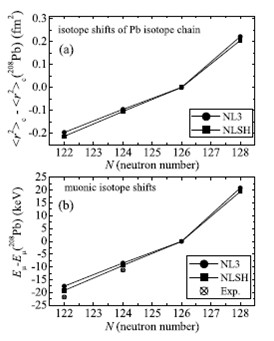A method that deals with the nucleons and the muon unitedly is employed to investigate the muonic lead, with which the correlation between the muon and the nucleus can be studied distinctly. A “kink” is found to appear in the muonic isotope shift at a neutron magic number where the nuclear shell structure plays a key role. This behavior is expected to have very important implications for probing experimentally the shell structure of the nuclei far away from the β-stable line.
By analyzing the variations of the nuclear structure due to the interaction with the muon in the muonic atom, the researchers in the Theoretical Physics Group at Institute of Modern Physics, Chinese Academy of Sciences (IMP), find that the nuclear structure remains basically unaltered, which indicates that the muon can be taken as a clean and reliable probe to extract information on nuclear structure. And this result also confirms theoretically that the previous experiments on the nuclear charge distributions and charge rms radii within the muonic atoms are reasonable and reliable.
It is shown that the muon-induced slight change in the proton density distribution in turn shifts the muonic levels and thus leads to a correction to the muonic level. This correction to the muonic level turns out to be comparable to the Lamb shift and high order vacuum polarization correction, but more important than the anomalous magnetic moment and electron shielding corrections.
The present research have proposed a new approach for experimentally probing the shell structure of the nuclei far from the beta-stable line via a “kink” in muonic isotope shift at the neutron magic number and revealed a direct link between nuclear physics and atomic physics. Part of the results is given in Fig.1.
The work has been published in Phys. Lett. B704 (2011) 600.
The paper can be found on the webpage:
http://www.sciencedirect.com/science/article/pii/S0370269311011300

Fig.1 (a) Nuclear isotope shifts of the Pb isotope chain; (b) muonic isotope shifts of 1s1/2 state in muonic Pb. The 208Pb is taken as a reference nucleus (Image by IMP)

